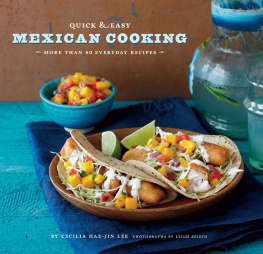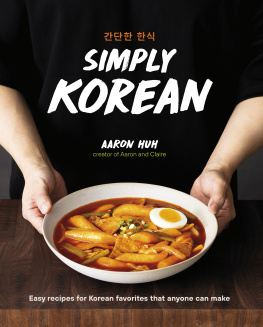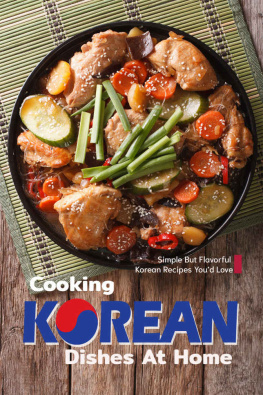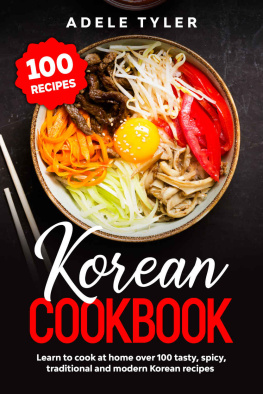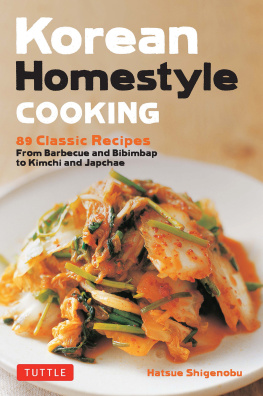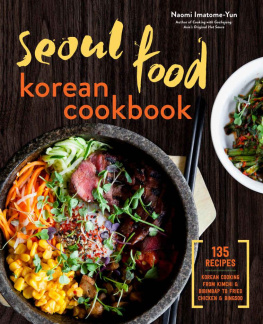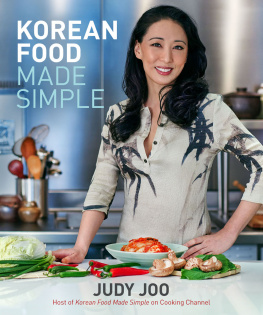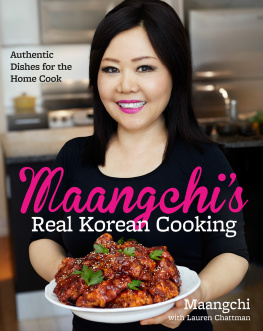quick & easy
korean
cooking

quick & easy
korean cooking
MORE THAN 70 EVERYDAY RECIPES
BY CECILIA HAE-JIN LEE
PHOTOGRAPHS BY JULIE TOY AND CECILIA HAE-JIN LEE

Text copyright 2009 by cecilia hae-jin lee .
Photographs copyright 2009 by julie toy .
Photographs on copyright 2009 by cecilia hae-jin lee .
All rights reserved. No part of this book may be reproduced in any form without written permission from the publisher.
Library of Congress Cataloging-in-Publication Data available.
ISBN 978-1-4521-2629-6
Design and Illustration by design army
Food styling by valerie aikman-smith
Typesetting by design army
Chronicle Books LLC
680 Second Street
San Francisco, California 94107
www.chroniclebooks.com

To my husband, Tim, who is my companion,
friend, and ultimate taste tester.


acknowledgments

Like a crowded kitchen alive with preparation for a large celebration, the efforts of many hands and minds help pull a book together. There are numerous peoplefamily, friends, strangerswho have shared their culinary wonders. I thank them for the meals Ive enjoyed and the knowledge of food theyve shared throughout the years.
I am grateful for my familymy mom Julia Mi-Ja, my dad Daniel Pal-Woo, my sister Catherine Hae-Ran, and my brother Sang. Theyve shared my love of food, given me a sense of adventure, and supported me through many meals and projects.
A big thank you to everyone at Chronicle Books, who helped create and support the physical book, especially Bill LeBlond for believing in the project, Anne Donnard for her wonderful design, Julie Toy for bringing my recipes alive in pictures, and Amy Treadwell for keeping us on track and pulling it all together.
I have to give a special thanks to my husband, Tim Maloney, whose patience, palate, and editing eye have contributed so much to this project. The kitchen would not be as clean without him and Im just glad he hasnt left me for his new loverthe dishwasher.
I also wish to thank my family in Korea: my Great Aunt, my Uncle Mangyu, and the family for their unwavering generosity with their home whenever their crazy American niece comes to town. Without my Aunt Younggyus car and my Aunt Jumis knowledge and companionship I wouldnt have been able to capture the photos I gathered during my travels. I realize through my large extended family that the food weve shared throughout the generations can be enjoyed for many more to come.



contents

introduction

I dont remember learning how to cook Korean food, just as I dont remember learning how to read. I do remember being too short to reach the counter and having to pull up a chair to the kitchen sink to wash the rice for dinner. Learning how to cook was a gradual process, starting with simple things like peeling potatoes and carrots for my mom and eventually leading to making feasts for dozens of family and friends.
I remember learning English, though, gradually understanding how the letters were formed, how they sounded, and how my mouth felt when saying certain words. Eventually English became so ingrained that I began thinking in it without having to translate it in my mind.
I think learning a new cuisine is very similar to learning a foreign language. You begin with small tastes at first, deciding that you like it and want to learn more about it. You take in more and more, and you gradually become confident enough to try it on your own.
Lucky for you Korean cooking is as easy as (if not easier than) learning the Korean language. Just as you can learn how to read the characters in an afternoon, the basics of Korean cuisine are not difficult to master.
Many people have the mistaken belief that making Korean food is a labor-intensive process. Maybe its all those photos of women crouched over giant bowls while making kimchi or the large tables of what looks to be hundreds of little dishes laid out for a royal banquet. Sure, there are some meals that may take an army of people to put together, but thats true of all cuisines. In modern time, Koreans, like everyone else, have to go to work, wrangle their kids, run their errands, and still get dinner on the table.
Korean cuisine emerged from centuries of life on a small peninsula at the edge of the Asian continent. Bordering China to the north and surrounded by oceans on its other three sides, Korea is graced with thousands of miles of coast, mountainous terrain, and fertile plains created by meandering rivers. The people have enjoyed foods from both farming the land and gathering from the sea for generations.
Korean cuisine ranges from bold flavors, infused with the aromas of garlic and chiles, to the more subtle delicacies of royal cuisine, enjoyed by the heirs of its long-lasting dynasties. Regional dishes have emerged over the yearsranging from special fruits or vegetables grown in an area to specific seafoods found near coastal towns.
Contrasts and complements are prevalent in Korean meals. Hot dishes are paired with cool liquids; spicy noodles are eaten with mild vegetables. As in their everyday lives, people strive to create a balance, yin and yang, on their dining table.
).
Present at every meal is the infamous kimchi. The most popular is the traditional napa cabbage variety (Ive provided a simplified version of the recipe on ), but its not uncommon to have two or more varieties available at the same meal. Served in small bowls, kimchi adds an extra kick to whatever else is on the table, even if other dishes may be red with chiles already.
Dining is a communal affair in Korea. All the side dishes (banchan) are laid out in the middle of the table for everyone to share. For an everyday meal, there may not be a main dish, but a number of smaller dishes to eat with the rice. The starring attraction might be a bubbling hot pot on a cold night, a lovely plate of barbecued beef for a summer lunch, or a grilled fish seasoned with a bit of sea salt. Whatever vegetables are in season make their way to the table, as well as some dried fish or pickled seafood.
A Korean meal is generally not served in courses, like a classic Western meal, but all at once. Everyone eats and talks and eats and talks until their rice bowls are empty. Leftover side dishes are usually saved for the next meal. Its a fun way to eat since even picky eaters can choose what they want, while the more adventurous can try a bit of everything.
Next page


